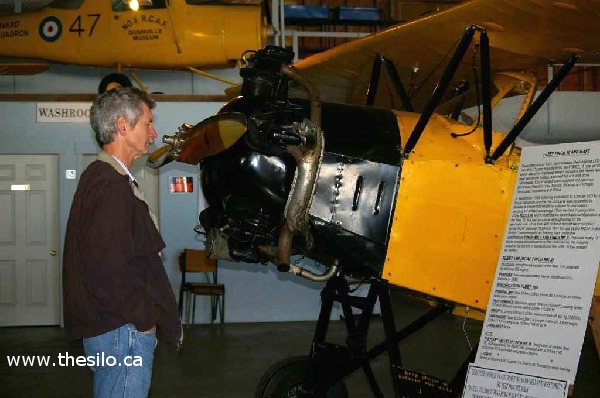Farmers Fly into RCAF Museum Last Fall, on Saturday, November 19th, 30 members and 2 guests of the Ontario Flying Farmers (OFF) paid a return visit to the No. 6 RCAF Dunnville Museum at the Dunnville Airport. Four planes flew in from the Goderich, Kincardine and the Elora area. Poor weather prevented more from flying in, but members drove in from as far as Peterborough. Adrian and Hortense Verburg were the conveners of the event. Adrian was one of the first members of the No. 6 RCAF Dunnville Museum.
Among other objectives, the Ontario Flying Farmers (O.F.F.) promote the practical use of airplanes in agriculture*, and encourage landing strips close to towns and cities. The O.F.F. promote safe flying through continued education and upgrading; help develop the public acceptance of light aircrafts; speak on behalf of farm familites at a national level and cooperate with aviation organizations to promote general aviation through legislation.
*Silo Direct Link to What is Aerial Topdressing?

The No. 6 RCAF Dunnville Museum, which they visited, preserves the memory and artifacts of the No. 6 Service Flying Training School. Part of the British Commonwealth Air Training Plan, the No. 6 was one of 41 such facilities built in Canada during WW II. The Museum, housed in half of Hangar 1, has 4 WW II trainers that still fly as well as extensive displays of course records, photographs, uniforms, training materials, flight log books and other RCAF-related artifacts from WW II.
The Flying Farmers is an international organization that was established in 1945, members are families or individuals interested in flying and or agriculture.
The OFF are celebrating their 50th year in 2011.More information is available by sending email to gc.paisley@hotmail.com Please mention that y0u found this article at The Silo.
Ian Durand is the Vice-President of the No. 6 RCAF Dunnville Museum. The museum is located at the Dunnville Airport at 536 Port Maitland Rd. in Dunnville. Contact information is available at Silo Direct Link to Dunnville Airport
Haldimand County – a big part of Canada’s air force history
The Second World War was a dark time in Canada’s history, and many may not know that Haldimand County was an integral part of our air training program.
Although there were no air raids in Canada, most towns nationwide had air raid sirens.
It was a time most can’t imagine. Take the uncertainty surrounding 9/11 and the subsequent war in Afghanistan and multiply it a thousand-fold. I remember the images of coffins being unloaded from military airplanes and people lining the bridges in a sombre salute watching the bodies of Canadians head to their final resting places.
There were 158 military personnel killed in Afghanistan. Petty Officer Second Class Douglas “Craig” Blake, who was born in Simcoe, had the unfortunate honour of being the first Royal Canadian Navy member to die in the conflict.
There was a sense of uncertainty at the time. Although there were no domestic attacks, there were threats. I can’t imagine how families of military personnel posted overseas felt. That sense was felt by one in 10 families in the Second World War given 1.1 million Canadians were serving in the military, with a population of about 12 million.
It’s hard to know if locals felt more secure with two air force bases in Haldimand County, or if the drone of trainers involved in the British Commonwealth Air Training Plan (BCATP) had an unnerving effect as residents wondered if it were friend or foe. The sight of Canada’s yellow Harvard planes provided fast reassurance of friendliness.
Canada set up BCATP in 1939 to train pilots from all Commonwealth countries. The remoteness and large, wide-open spaces made it an ideal location. Existing airfields were transitioned to military use, and many more were built increasing the total number of installations to 231. Several local locations were part of the program.
Harvards and Yales flew out of Dunnville. Hagersville airfield hosted Harvards and two-engine Avro Ansons. Both were Service Flying Training Schools for pilots in the second stage of training. Those trained in Harvards and Yales became fighter pilots, while Anson pilots were assigned to bombers. Brantford also had a base, and today’s Ontario Police College in Aylmer was the site for training both fighter and bomber pilots.
Dunnville’s No. 6 Service Flying Training School was one of the first locations to train fighter pilots. Today, it’s home to the No.6 RCAF museum, which includes operating aircraft, photos, and memorabilia. I was at the museum just a few weeks ago and crawled inside some of the aircraft. I had a difficulty comprehending how anyone could spend several hours in an aircraft that appears impossible to get off the ground.
Each base was required to have a relief landing field in case the primary runway was disabled. Cayuga was the site of one of these. Tillsonburg, which is now home to the Canadian Harvard Aircraft Association, was another. Jarvis also had a base, but it wasn’t one of the relief sites.
By war’s end, the BCATP had graduated more than 130,000 personnel from Canada, Britain, Australia and New Zealand. Canada then had the fourth-largest allied air force.
Today, fewer than 100 40-year-old jets make up our entire stable of fighters. Those fighters are located at just two bases. The good news is new F-35s are coming, although cancellation fees associated with the on-again, off-again political football added to the cost and delayed the planes.
Bobbi Ann Brady MPP for Haldimand-Norfolk
The Ontario Flying Farmers of Ontario Association have been a lifetime member of the Ontario Agricultural Hall of Fame. You can visit the Hall of Fame’s website at http://www.oahf.on.ca.
To update the Hall of Fame member list would you please forward to me the name of the appropriate contact person and the current mailing address.
Thank you for assisting us to keep our membership list current.
Reg Cressman
Secretary/Treasurer
Ontario Agricultural Hall of Fame
thanks for a very good article Don